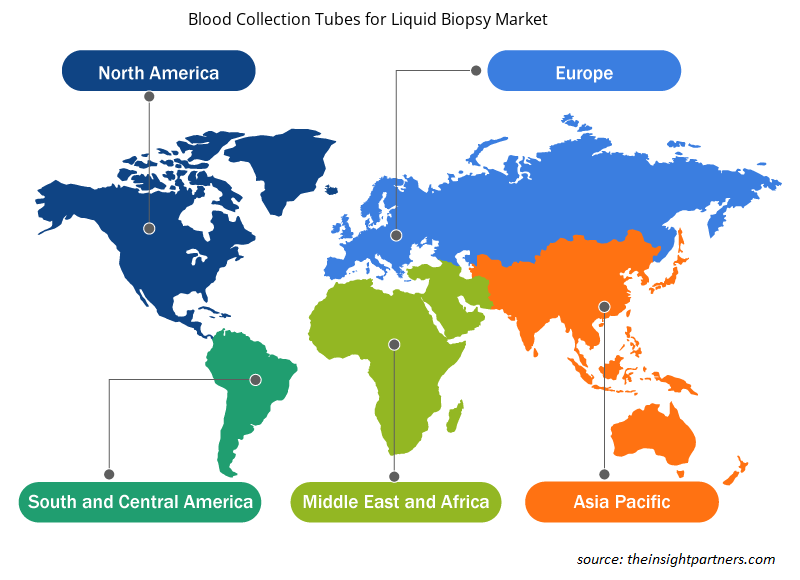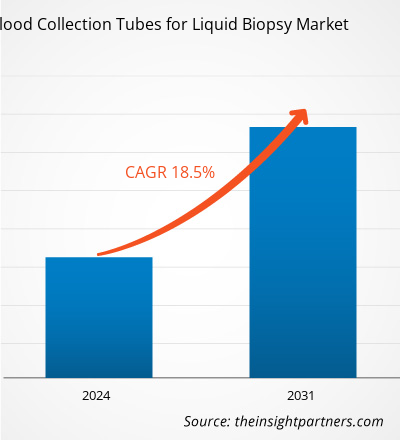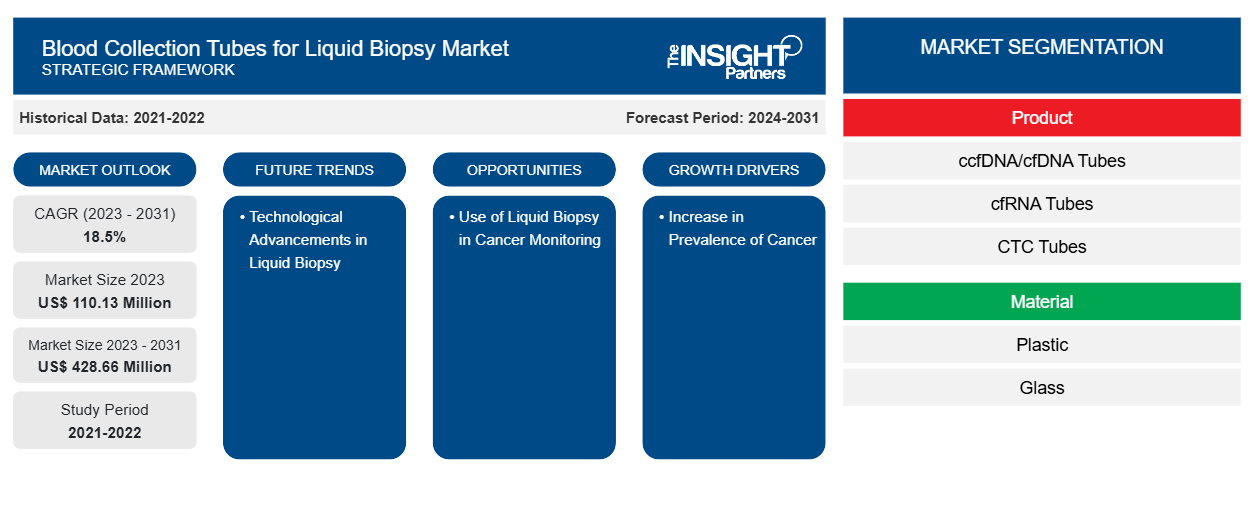液体活检用采血管市场规模预计将从 2023 年的 1.1013 亿美元增至 2031 年的 4.2866 亿美元。预计 2023-2031 年期间市场复合年增长率将达到 18.5%。随着需要进行血液检测以进行诊断和监测病情进展的慢性病发病率不断上升,技术先进的液体活检用采血管很可能仍是市场的主要趋势。
液体活检采血管市场分析
推动液体活检采血管市场增长的关键因素之一是癌症发病率的上升以及对非侵入性诊断工具的需求激增。随着用于早期疾病检测的新生物标记物研发活动的不断开展,液体活检采血管市场也在不断扩大。吞吐量采血管的发展表明,为液体活检程序设计的采血管有了显著的改进。
液体活检采血管市场概况
随着癌症发病率的上升,印度对液体活检等高度复杂、侵入性较小的诊断技术的需求也在增加。由于这些程序具有微创性,因此可以比传统的组织活检更频繁地进行。因此,随着印度实施的液体活检程序数量的激增,用于液体活检的采血管市场正在大幅扩张。据印度医学研究理事会称,2022 年印度诊断出的癌症新病例估计为 146 万例。在印度,预计每 9 人中就有 1 人在一生中的某个时刻被诊断出患有癌症。乳腺癌是女性中最常见的癌症,而肺癌是男性中最常见的癌症类型。淋巴细胞白血病是儿童中最常见的癌症类型,影响 0-14 岁年龄段的 29.2% 的男孩和 24.2% 的女孩。不断取得的进步,例如增强的检测技术和更灵敏的设备,正在使液体活检程序更加可靠和易于使用。此外,随着人们对液体活检优势的认识不断提高,包括早期检测、治疗效果监测和预防复发,预计将在未来几年使印度等发展中国家的市场受益。
定制此报告以满足您的需求
您可以免费定制任何报告,包括本报告的部分内容、国家级分析、Excel 数据包,以及为初创企业和大学提供优惠和折扣
- 获取此报告的关键市场趋势。这个免费样品将包括数据分析,从市场趋势到估计和预测。
液体活检采血管市场驱动因素和机遇
液体活检相较于其他诊断检测技术的优势有利于市场增长
侵入性诊断程序会增加血肿、出血和组织损伤的风险,从而将肿瘤细胞植入周围组织。因此,越来越多的患者倾向于进行非侵入性或微创性检测以进行诊断。研究人员可以通过对血液样本进行液体活检来追踪实体肿瘤中的所有遗传和表观遗传变化。由于液体活检是一种非侵入性诊断技术,因此患者的风险较小。此外,临床医生可以轻松地多次进行这些测试,因为这些程序不会给患者带来太多不适。患者更喜欢微创手术,因为可以使用先进的仪器,这些仪器可以让临床医生或实验室人员进行更精细和复杂的工作,而不会造成太多疼痛、疤痕和其他风险。由于技术进步提高了可行性并缩短了处理时间,液体活检作为癌症患者组织活检的非侵入性替代方案,最近引起了人们的极大兴趣。
计算机断层扫描 (CT)、磁共振成像 (MRI) 和正电子发射断层扫描 (PET) 等成像技术既昂贵又耗时。此外,它们还会使患者暴露于外部辐射、静脉造影剂和放射性示踪剂等。成像研究也无法提供有关肿瘤表型的任何信息,而肿瘤表型可能会随着所给予的治疗而改变。尽管组织活检技术可以提供有关肿瘤表型的信息,但考虑到成本限制和患者风险,进行连续组织活检是不可行的。相反,液体活检可以以相对较低的成本提供几乎连续的癌症负担和表型信息评估。液体活检提供了评估各种生理或病理生理过程的非侵入性或微创方法,从而取代了组织活检或其他侵入性程序。在这种情况下,液体活检可以通过分析血液样本中的循环肿瘤细胞或循环游离核酸来避免内窥镜检查、针吸活检或手术的需要。
液体活检在癌症监测中的应用为市场提供增长机会
研究人员高度关注液体活检程序在监测癌症生长、检测基因突变、识别复发迹象和预测免疫疗法敏感性方面的能力。早期发现癌症会带来更好的结果;例如,早期发现的患者的缓解率和存活率高于晚期或恶性癌症患者。然而,在症状不明显的早期阶段进行连续放射学检测或侵入性癌症监测程序以检测癌症是不切实际的。液体活检开启了通过常规抽血或尿液分析进行定期癌症筛查的可能性。它可以识别高度特异性和循环标记物以进行早期癌症检测。
液体活检程序也用于癌症患者的治疗后监测。治疗后,癌细胞可能在体内持续存在,但其水平低于影像学研究的分辨率和检测水平;这种情况被称为微小残留病。这种疾病被认为是癌症缓解的主要原因。与癌症筛查和早期检测类似,液体活检的临床应用受到当前测试的敏感性和特异性的限制。这种敏感性限制使得液体活检技术更适合检测实体肿瘤而非血癌的微小残留病。借助液体活检,医疗保健专业人员可以监测癌症复发的情况,然后通过正确的诊断尽早治疗。
最初对特定酪氨酸激酶抑制剂(包括吉非替尼、厄洛替尼、克唑替尼和色瑞替尼)敏感的肿瘤经常发生变异并对这些药物产生耐药性。液体活检可检测肿瘤状态的变化,并帮助医生修改治疗策略,以避免患者体内对任何药物产生耐药性。因此,液体活检可以早期发现癌症,并帮助医疗保健专业人员确定治疗的确切行动方案。此外,它还有助于监测治疗和治疗后患者的状况。因此,人们越来越关注液体活检在癌症患者监测中的应用,这可能会在预测期内对液体活检程序的采血管产生大量需求。
液体活检采血管市场报告细分分析
促成液体活检采血管市场分析的关键部分是产品、材料、应用和最终用户。
- 根据产品,液体活检采血管市场分为 ccfDNA 管、cfRNA 管、CTC 管、gDNA 管、细胞内 RNA 管等。ccfDNA/cfDNA 管细分市场在 2023 年占据最大市场份额。
- 根据材料,液体活检采血管市场分为玻璃和塑料。2023 年,塑料部分占据了较大的市场份额。
- 根据应用,市场分为体外诊断 (IVD) 和研究。体外诊断 (IVD) 领域在 2023 年占据了更大的市场份额。
- 根据最终用户,液体活检采血管市场分为基因诊断实验室、研发中心、传统诊断中心等。基因诊断实验室部分在 2023 年占据了最大的市场份额。
液体活检采血管市场份额(按地区)分析
液体活检采血管市场报告的地理范围主要分为五个地区:北美、亚太地区、欧洲、南美和中美以及中东和非洲。2023 年,北美占据了市场主导地位。技术先进产品的接受度不断提高、研发活动的增加、大型医疗保健企业的存在以及 FDA 对液体活检的批准数量不断增加,是推动北美液体活检采血管市场发展的关键因素。预计亚太地区在预测期内的复合年增长率最高。随着癌症患病率的飙升、对创新诊断解决方案开发的高支出以及重要市场参与者的存在,美国的液体活检程序市场正在蓬勃发展。
液体活检采血管市场区域洞察
Insight Partners 的分析师已详细解释了预测期内影响液体活检采血管市场的区域趋势和因素。本节还讨论了液体活检采血管市场的各个部分和地理位置,包括北美、欧洲、亚太地区、中东和非洲以及南美和中美洲。

- 获取液体活检采血管市场的区域特定数据
液体活检采血管市场报告范围
| 报告属性 | 细节 |
|---|---|
| 2023 年的市场规模 | 1.1013亿美元 |
| 2031 年市场规模 | 4.2866亿美元 |
| 全球复合年增长率(2023 - 2031) | 18.5% |
| 史料 | 2021-2022 |
| 预测期 | 2024-2031 |
| 涵盖的领域 | 按产品
|
| 覆盖地区和国家 | 北美
|
| 市场领导者和主要公司简介 |
|
液体活检采血管市场参与者密度:了解其对业务动态的影响
液体活检采血管市场正在快速增长,这得益于终端用户需求的不断增长,而这些需求又源于消费者偏好的不断变化、技术进步以及对产品优势的认识不断提高等因素。随着需求的增加,企业正在扩大其产品范围,进行创新以满足消费者的需求,并利用新兴趋势,从而进一步推动市场增长。
市场参与者密度是指在特定市场或行业内运营的企业或公司的分布情况。它表明在给定市场空间中,相对于其规模或总市场价值,有多少竞争对手(市场参与者)存在。
在液体活检采血管市场运营的主要公司有:
- Biocept公司
- F. 霍夫曼-罗氏有限公司
- 斯特莱克公司
- Norgen Biotek 公司
- 精确科学公司
- MagBio Genomics 公司
免责声明:上面列出的公司没有按照任何特定顺序排列。

- 获取液体活检采血管市场主要参与者概览
液体活检采血管市场新闻及最新发展
通过收集一手和二手研究后的定性和定量数据来评估液体活检采血管市场,其中包括重要的公司出版物、协会数据和数据库。近年来市场发生的重大发展之一如下:
- Exact Science Corporation 宣布在马里兰州巴尔的摩市建立 Haystack Oncology 设施。这家新企业最近筹集了 5600 万美元的资金,由纽约投资公司 Catalio Capital Management 牵头。Haystack 正在开发一种血液检测方法,可以检测出来自实体肿瘤的微量循环 DNA,从而表明癌症的存在及其可能的复发。(来源:Exact Science Corporation,公司网站,2022 年 11 月)
液体活检采血管市场报告覆盖范围和交付成果
“液体活检采血管市场规模和预测(2021-2031)”报告对市场进行了详细的分析,涵盖以下领域:
- 液体活检用采血管市场规模及预测,涵盖范围涵盖的所有关键细分市场的全球、区域和国家层面
- 液体活检采血管市场趋势以及市场动态,如驱动因素、限制因素和关键机遇
- 详细的 PEST/波特五力分析和 SWOT 分析
- 液体活检采血管市场分析,涵盖关键市场趋势、全球和区域框架、主要参与者、法规和最新市场发展
- 行业格局和竞争分析,涵盖市场集中度、热图分析、知名参与者以及液体活检采血管市场的最新发展
- 详细的公司简介
- 历史分析(2 年)、基准年、预测(7 年)及复合年增长率
- PEST和SWOT分析
- 市场规模、价值/数量 - 全球、区域、国家
- 行业和竞争格局
- Excel 数据集
近期报告
相关报告
客户评价
购买理由
- 明智的决策
- 了解市场动态
- 竞争分析
- 客户洞察
- 市场预测
- 风险规避
- 战略规划
- 投资论证
- 识别新兴市场
- 优化营销策略
- 提升运营效率
- 顺应监管趋势





















 获取免费样品 - 液体活检市场用采血管
获取免费样品 - 液体活检市场用采血管